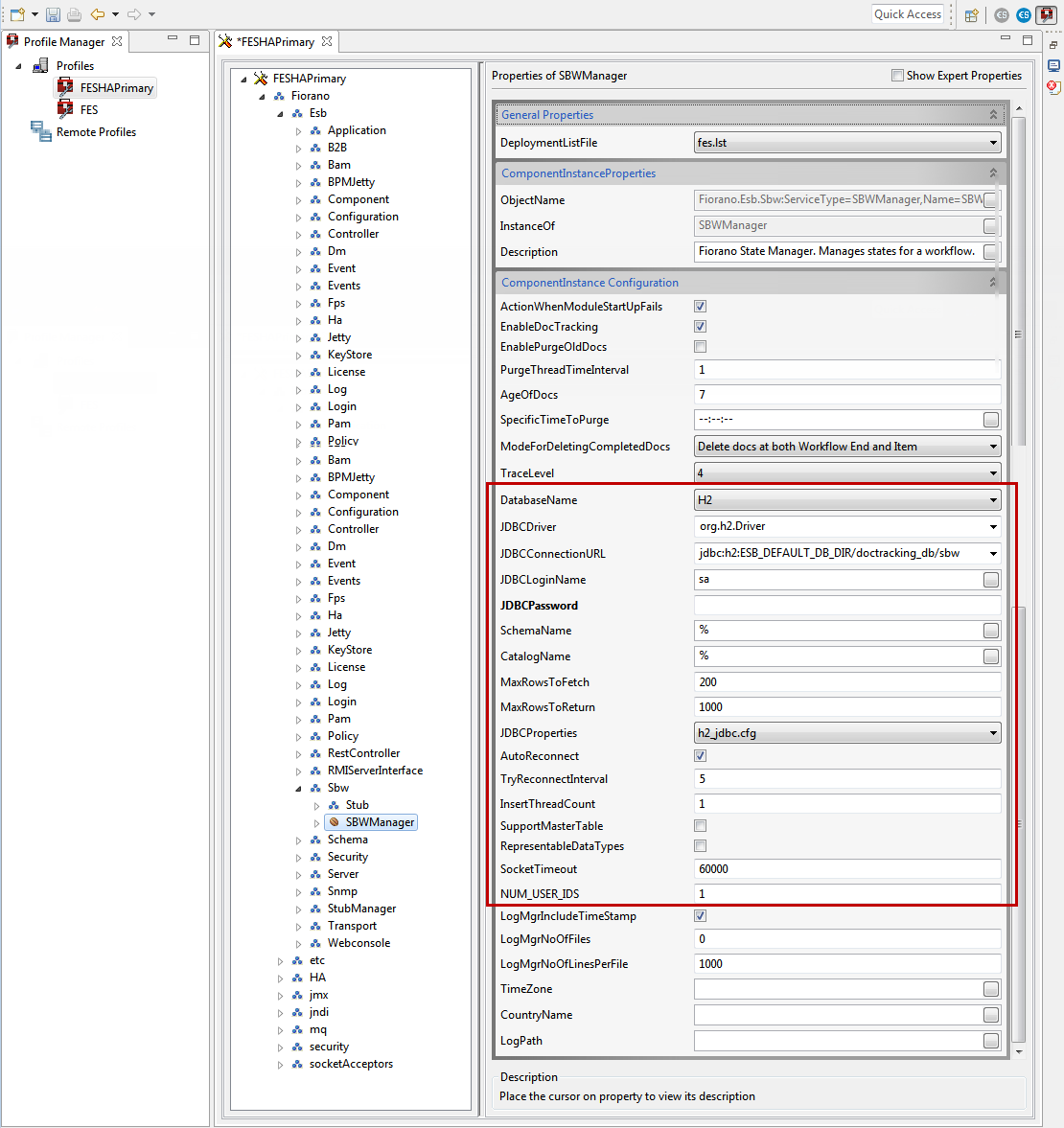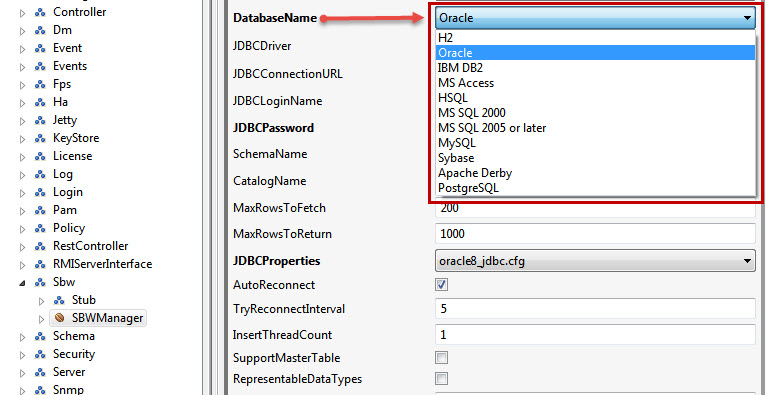The document tracking feature is configured as part of FES to track SBW events into the database running within Enterprise Server.
Viewing and Configuring the SBW Manager properties
Configuring the SBW Manager properties in eStudio
To view or configure the database, perform the following actions on the Profile Management perspective:
Load the profile and navigate to FES > Fiorano > Esb > Sbw > SBWManager. The Properties of SBWManager dialog box on the right displays all the database properties along with their default values.

Select the required database from the Database Name property drop-down and modify values of other properties too accordingly.

- Click the Save button or press CTRL+S to save the profile changes.
Configuring SWB Database in Fiorano Dashboard
In the left navigation panel, go to Document Tracking > SBW DB Configuration, provide the database-specific values, click the Save Configurations button and restart the server.

For file-based databases like apache and HSQL, the default location is in the ESB_USER_DIR (which is set in fiorano_vars script). Provide the complete path with these variables resolved when using the JDBC URL in a third party tool.
SBW Database Property descriptions
| Database Name | JDBC Driver | JDBC Connection URL (Default Formats) | JDBC Properties |
| H2 | org.h2.Driver | jdbc:h2:ESB_DEFAULT_DB_DIR/doctracking_db/sbw | h2_jdbc.cfg |
| Oracle | oracle.jdbc.driver.OracleDriver | jdbc:oracle:thin:<ip-address>:<port>:<databaseName> | oracle8_jdbc.cfg |
| IBM DB2 | sun.jdbc.odbc.JdbcOdbcDriver | jdbc:odbc:sample | db2_jdbc.cfg |
| MS Access | sun.jdbc.odbc.JdbcOdbcDriver | jdbc:odbc:Driver={Driver do Microsoft Access (*.mdb)};DBQ=D:\\tif\\bin\\sp\\sbw.mdb | msaccess_jdb.cfg |
| HSQL | org.hsqldb.jdbcDriver | jdbc:hsqldb:ESB_DEFAULT_DB_DIR/doctracking_db/sbw | hsql_jdbc.cfg |
| MS SQL 2000 | com.microsoft.jdbc.sqlserver.SQLServerDriver | jdbc:microsoft:sqlserver://<ip-address>:<port>;SelectMethod=Cursor | mssql_jdbc.cfg |
MS SQL 2005 or later | com.microsoft.sqlserver.jdbc.SQLServerDriver | jdbc:sqlserver://<ip-address>:<port>;databaseName=<databaseName>;SelectMethod=Cursor | mssql_jdbc.cfg |
| MySQL |
|
| mysql_jdbc.cfg |
| Sybase | com.sybase.jdbc2.jdbc.SybDriver | jdbc:sybase:Tds:<ip-address>:<port>/<databaseName> | sybase_jdbc.cfg |
| Apache Derby | org.apache.derby.jdbc.EmbeddedDriver | jdbc:derby:ESB_DEFAULT_DB_DIR/doctracking_db/sbw;create=true | derby_jdbc.cfg |
| Postgre SQL | org.postgresql.Driver | jdbc:postgresql://<ip-address>:<port>/<databasename> | pgsql_jdbc.cfg |
Descriptions of common properties are listed below:
| Properties | Descriptions | Default Value |
| JDBC Login Name | Username to be used for jdbc database connection | <DB dependent> |
| JDBC Password | Password to be used for jdbc database connection | <DB dependent> |
| Scheme Name | By default, the schema name will be %, i.e., all schemas are searched. | % |
| Catalog Name | By default, the catalog name will be %, all catalogs. | % |
| Max Rows To Fetch | Maximum No Of Rows to Fetch. | 200 |
| Max Rows To Return | Maximum No Of Rows to Return. | 1000 |
| Auto Reconnect | Boolean to specify whether SP should try for reconnection with DB automatically. | Enable/Disable |
| Try Reconnect Interval | Interval (in secs) after which SP tries to reconnect with DB in case of a break in connection. | 5 |
| Insert Thread Count | Number of threads used for inserting SBW data into the database. | 1 |
| Support Master Table | Enable if backward compatibility with earlier SBW schema (1001) is required. | Enable/Disable |
| Representable Data Types | Enable to store MESSAGE in representable data format. | Enable/Disable |
| Socket Timeout | Read timeout while reading from the socket. |
|
| Num User IDs | Number of user-defined document IDs the user wants to use in the setup. | 1 |
Points to Note
For file-based databases like apache and HSQL, the default location is in the ESB_USER_DIR (which is set in fiorano_vars script). Provide the complete path with these variables resolved when using the JDBC URL in a third party tool.